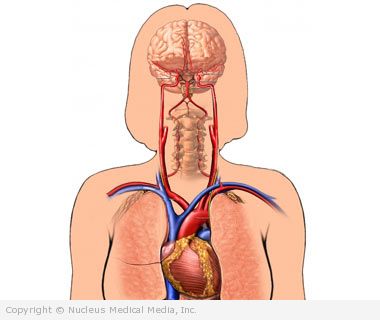Fainting – Syncope
Fainting – Definition
Fainting is the sudden loss of consciousness.
Fainting – Causes
In general, fainting is caused by decreased blood flow to the brain.
This can occur due to:
- Vasovagal spells (most common cause) — simple fainting that can occur:
- During medical procedures
- During times of high stress, trauma, or fright
- After standing still for a long period of time
- Low blood pressure, especially when standing (called orthostatic hypotension)
- Dehydration
- Anemia due to blood loss
- Hypoglycemia (low blood sugar)
- Side effect of a medicine
- Seizure
- Stroke or transient ischemic attack
- Too rapid or too slow heart rhythm, abnormal rhythm
- Organic heart problems such as:
- Hypertrophic cardiomyopathy
- Pulmonary stenosis
- Constrictive pericarditis
Fainting – Risk Factors
Risk factors include:
- Heart disease, especially congestive heart failure or abnormal rhythms
- Blood loss
- Medicines, including:
- Blood pressure medicines
- Drugs that enlarge blood vessels
- Drugs that regulate the heart’s rhythm
- Water pills ( diuretics)
Fainting – Symptoms
Symptoms include:
- Sudden loss of consciousness
- Inability to remain standing or sitting
- Consciousness regained without any need for intervention
- Dizziness or light-headedness before losing consciousness
When Should I Call My Doctor?
Call your doctor if you are having episodes of fainting. This is especially important if you:
- Have a heart condition
- Have a job where you or others may be at risk if you faint (eg, airline pilot, bus driver, machinist)
When Should I Call for Medical Help Immediately?
Call for medical help or go to the emergency room right away if you have:
- Weakness or numbness of face, arm, or leg, especially on the left side of the body
- Confusion
- Loss of balance, coordination problems
- Vision problems
- Severe headache
- Rapid, irregular heartbeat; chest pain
Fainting – Diagnosis
The doctor will ask about your symptoms and medical history, and perform a physical exam.
Tests may include:
- Blood tests — to look for anemia, hypoglycemia, low potassium, and low magnesium
- Electrocardiogram (ECG) — a test that records the heart’s activity by measuring electrical currents through the heart muscle
- Holter monitoring — a mobile ECG test that is performed over 24 hours (or more) while you go about your usual daily activities
- Head computed tomography (CT) scan — a type of x-ray that uses a computer to make pictures of the brain
- Electroencephalogram (EEG) — a test that records the brain’s activity by measuring electrical currents through the brain
- Magnetic resonance imaging (MRI) scan of the brain — a test that uses magnetic waves to make pictures of structures inside the head
- Echocardiogram — a test that uses high-frequency sound waves (ultrasound) to examine the size, shape, and motion of the heart
- Tilt table testing— a tilted table that is used to provoke syncopal symptoms (medicine may be used)
- Cardiac catheterization — a tube-like instrument inserted into the heart through a vein or artery (usually in the arm or leg) to detect problems with the heart and its blood supply
- Magnetic resonance angiogram (MRA) and CT angiogram (CTA) tests — to evaluate the blood vessels inside the brain
Fainting – Treatment
Treatment will depend on the underlying condition that has caused fainting, for example:
- Abnormal heart rhythms can be treated with medicines or by implanting a pacemaker.
- If medicine is causing syncope, it may need to be changed or discontinued.
- Anemia or other blood abnormalities should be treated.
If you are diagnosed as having fainted, follow your doctor’s instructions.
Fainting – Prevention
If you are prone to fainting:
- Know the warning signs (eg, dizziness, light-headedness). If you feel that you are going to faint, sit or lie down right away.
- Get up slowly and carefully from lying down. Start by sitting up for a minute and then stand up.
- Drink plenty of fluids.
- Discuss dietary changes with your doctor.
- Avoid using alcohol or other drugs.
There are certain physical counterpressure maneuvers that are designed to rapidly raise blood pressure and increase blood flow to the brain. When these maneuvers are done during warning signs, you may be able to prevent fainting. Examples of these maneuvers include:
- Crossing the legs while tensing the muscles of the legs, abdomen, and buttocks
- Forcefully squeezing a rubber ball or any other available object as hard as possible in the dominant hand
- Gripping one hand with the other while tensing both arms and raising the elbows slightly

